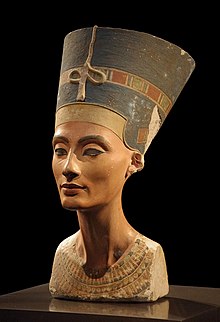
The history of cosmetics spans at least 7,000 years and is present in almost every society on earth. Cosmetic body art is argued to have been the earliest form of a ritual in human culture. The evidence for this comes in the form of utilised red mineral pigments (red ochre) including crayons associated with the emergence of Homo sapiens in Africa.[1][2][3][4][5][6] Cosmetics are mentioned in the Old Testament—2 Kings 9:30 where Jezebel painted her eyelids—approximately 840 BC—and the book of Esther describes various beauty treatments as well.
Cosmetics were also used in ancient Rome, although much of Roman literature suggests that it was frowned upon. It is known that some women in ancient Rome invented make up including lead-based formulas, to whiten the skin, and kohl to line the eyes.[7]
- ^ Power, Camilla (2010). "Cosmetics, identity and consciousness". Journal of Consciousness Studies. 17 (7–8): 73–94.
- ^ Power, Camilla (2004). "Women in Prehistoric Art". In Berghaus, G. (ed.). New Perspectives in Prehistoric Art. Westport, CT & London: Praeger. pp. 75–104.
- ^ Watts, Ian (2009). "Red ochre, body painting and language: interpreting the Blombos ochre". In Botha, Rudolf; Knight, Chris (eds.). The Cradle of Language. OUP Oxford. pp. 62–92. ISBN 978-0-19-156767-4.
- ^ Watts, Ian (1 September 2010). "The pigments from Pinnacle Point Cave 13B, Western Cape, South Africa". Journal of Human Evolution. 59 (3): 392–411. doi:10.1016/j.jhevol.2010.07.006. PMID 20934093.
- ^ Adkins, Lesley & Adkins, Roy A. (1998). Handbook to life in Ancient Greece. Oxford University Press. ISBN 978-0-19512-491-0.[page needed]
- ^ Burlando, Bruno; Verotta, Luisella; Cornararara, Laura & Bottini-Massa, Elisa (2010). Herbal Principles in Cosmetics. Boca Raton, FL: CRC Press. ISBN 978-1-43981-213-6.
- ^ Olson, Kelly (2009). "Cosmetics in Roman Antiquity: Substance, Remedy, Poison". Classical World. 102 (3): 291–310. doi:10.1353/clw.0.0098. JSTOR 40599851. S2CID 144834720. Project MUSE 266767.